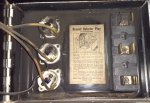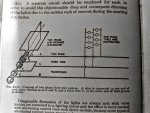mbrooke
Batteries Included
- Location
- United States
- Occupation
- Technician
You need a separate EGC for corner ground and ungrounded systems as well beyond the service or first means of disconnect. So yes you run 4 wires with branch circuits and feeders, or 5 if there is a neutral.
Corner ground and ungrounded systems are still referred to as three phase three wire systems though. If you have a three phase four wire "system" that means there is a neutral conductor involved even if it has no load connected to it.
Main disconnect- sorry .
But yes, I agree.






